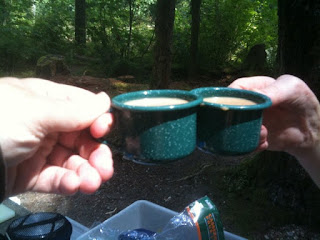Sure warms the fingers when it's cold."
- from the
song, "God Must Be a Cowboy at Heart," by Dan Seals, © 1983
We've come a long way from the days when "cowboy"
coffee was a camper's only choice. While an occasional tin cup of that strong
but gritty brew is fine, today's coffee-quaffing campers have almost as many
choices on the trail as do city-dwelling caffeine hounds.
 |
| Cappuccinos up! |
While it might be considered "retro", you can
still use this old method of throwing grounds in boiling water, then drinking
(and often chewing!) the results. All you need are a black enamel pot, a campfire
and ground coffee
There are different schools of thought about the best way to
brew campfire or cowboy coffee. Add a handful of fresh grounds to a pot of cold
water and boil it; or, boil it then add the grounds (my preferred method). Some
campfire chefs throw in crushed eggshells - or even a whole egg! - to help the grounds settle, but I've never
subscribed to that.
Whichever method you choose, when the grounds sink, the
coffee is ready.
Coffee, percolator style
When my regular camping partner tired (very
quickly!) of my cowboy coffee on our early trips together, we switched to a
percolator to keep the grounds out of the water.
 |
| The coffee is a-brewin'... |
I remember this as the preferred method on all our family
camping trips. Of course, my dad wasn't a cowboy and the cappuccino craze
hadn't hit North America, then. The first percolators were made in 1825, so it
is a tried-and-true method of coffee brewing.
The method is simple: fill the basket with coffee, the pot
with water, boil it then percolate it until the coffee is as strong as you like
it. You'll need to experiment to determine how long to percolate it to reach
the desired strength.
Campers can "espresso" themselves
These hit the market in the early 1990s. My partner still
wasn't crazy about my camp coffee, so I bought this little device for her
birthday one year. (She's never complained about my coffee since - or about any
birthday present, either.)
Brewing with this set-up is similar to using a percolator:
fill a basket with espresso-grind, fill the pot with water, then heat it until
the coffee is forced up through the upper chamber and nozzle into your waiting
cups. Once the brew is out, there is still enough steam coming from the nozzle
to froth milk if you want to turn your espresso into cappuccino.
 |
| Who's up for camp espresso? |
This works best over a portable stove, or a Coleman stove, than a campfire. Place a cup (metal!) on the lid to catch the coffee
before it starts coming out, because when it is ready, it comes out very fast!
Press-ing on to new coffee frontiers
So-called "French presses" or plunger pots became
all the rage in homes about the same time campfire cappuccinos became
available. Now they are available for camping, either as plunger pots or
press/cup combinations, in which the press/plunger doubles as a lid.
The method is very simple: boil water, add it to grounds in
the pot/mug, steep to the desired strength, then press the plunger down. Pour
it into a mug, and voila! - a strong cup of java without grounds. Aficionados
claim it is closer to a "true" coffee taste, although having chewed a
few chocolate-covered coffee beans in my time, I can vouch it still doesn’t
compare to the taste (or kick!) of a few of those caffeine-packed goodies.
Whatever method you choose, a drop or two of Bailey's always seems to make it go down even better.
To put you in the mood, I'll leave you with this music video by Jerry Vandiver, dedicated to those of us who really appreciate their coffee in camp.
It's tough to beat the scenery and ambiance of coffee enjoyed in the outdoors.
(A slightly different version of this was originally published in Coast Magazine, July 2001, B.C. edition)


